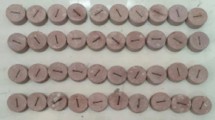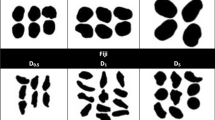Abstract
The temperature of dry ice is very low, about –78.5 °C. When it contacts with high-temperature rock, it will cause some damage to the rock. This paper takes sandstone as the research object; dry ice is used to rapidly cool the rock after high-temperature treatment at different temperatures (25–800 °C). The pore fracture development and permeability changes are measured by nuclear magnetic resonance (NMR) technology, and the following conclusions are obtained: (1) cracks appear on the surface of the sample after treatment at 500 °C, when the temperature reaches 600 °C, the number of internal micropores (0 ms < T2 < 10 ms) increases significantly; (2) the thermal expansion of calcite, the phase transformation of quartz, and the thermal stress impact effect under extreme temperature difference after dry ice cooling are the main reasons for the change of permeability; (3) the rapid cooling of ultra-low-temperature dry ice intensifies the thermal damage of sandstone. Compared with natural cooling, dry ice cooling improves the porosity and permeability of sandstone more significantly.











Similar content being viewed by others
References
Alqatahni NB, Cha M, Yao B, Yin XL, Kneafsey TJ, Wang L, Wu YS, Miskimins JL (2016) Experimental investigation of cryogenic fracturing of rock specimens under true triaxial confining stresses. Spe Europec Featured Eage Conf Exhibition, 301591284. https://doi.org/10.2118/180071-MS
Bradford J, Ohren M, Osborn WL, McLennan J, Moore J, Podgorney R (2014) Thermal stimulation and injectivity testing at Raft River. In Proceedings of 39th Workshop on Geothermal Reservoir Engineering, Stanford, CA, USA 2014 Feb 24–26, 2014.
Cai Y, Liu D, Pan Z, Yao Y, Li J, Qiu Y (2013) Petrophysical characterization of chinese coal cores with heat treatment by nuclear magnetic resonance. Fuel 108:292–302. https://doi.org/10.1016/j.fuel.2013.02.031
Cha M, Yin X, Kneafsey T, Johanson B, Alqahtani N, Miskimins J, Patterson T, Wu YS (2014) Cryogenic fracturing for reservoir stimulation—laboratory studies. J Petrol Sci Eng 124:436–450. https://doi.org/10.1016/j.petrol.2014.09.003
Dong ZH (2020) Study on Thermal Damage and Evaluation of Overburden Rock in Underground Coal Gasification. China University of Mining and Technology. (in Chinese)
Gaunt HE, Sammonds PR, Meredith PG, Chadderton A (2016) Effect of temperature on the permeability of lava dome rocks from the 2004–2008 eruption of Mount St. Helens B Volcanol 78(4):30. https://doi.org/10.1007/s00445-016-1024-5
Gautam PK, Dwivedi R, Kumar A, Kumar A, Verma AK, Singh KH, Singh TN (2020) Damage characteristics of Jalore granitic rocks after thermal cycling effect for nuclear waste repository. Roch Mech Rock Eng 6:1–20. https://doi.org/10.1007/s00603-020-02260-7
Glover PW, Baud P, Darot M, Meredith P, Boon SA, LeRavalec M, Zoussi S, Reuschlé T (1995) α/β phase transition in quartz monitored using acoustic emissions. Geophys J Int 120(3):775–782. https://doi.org/10.1111/j.1365-246X.1995.tb01852.x
Hajpal M (2002) Changes in sandstones of historical monuments exposed to fire or high temperature. Fire Technol 38(4):373–382. https://doi.org/10.1023/A:1020174500861
Hassanzadegan A, Blocher G, Milsch H, Urpi L, Zimmermann G (2014) The effects of temperature and pressure on the porosity evolution of Flechtinger sandstone. Rock Mech Rock Eng 47(2):421–434. https://doi.org/10.1007/s00603-013-0401-z
Hettema MH, Niepce DV, Wolf KH (1999) A microstructural analysis of the compaction of claystone aggregates at high temperatures. Int J Rock Mech Min 36(1):57–68. https://doi.org/10.1016/S0148-9062(98)00178-8
Hodot B (1966) Outburst of coal and coalbed gas (Chinese translation). China Coal Industry Press, Beijing, p 318
Hou X, Zhu Y, Wang Y, Liu Y (2019) Experimental study of the interplay between pore system and permeability using pore compressibility for high rank coal reservoirs. Fuel, 254:115712. https://doi.org/10.1016/j.fuel.2019.115712
Jin P, Hu Y, Shao J, Liu Z, Feng G, Song S (2020) Influence of temperature on the structure of pore–fracture of sandstone. Rock Mech Rock Eng 53(1):1–12. https://doi.org/10.1007/s00603-019-01858-w
Jing X, Sun Q, Jia H, Ge Z, Wang T (2021) Influence of high-temperature thermal cycles on the pore structure of red sandstone. Bull Eng Geol Env 80(10):7817–7830. https://doi.org/10.1007/s10064-021-02389-x
Kim KM, Kemeny J (2009) Effect of thermal shock and rapid unloading on mechanical rock properties. In43rd US Rock Mechanics Symposium & 4th US-Canada Rock Mechanics Symposium. Am Rock Mech Assoc https://doi.org/10.1007/s00603-013-0523-3
Kozusnikova A, Konecny P (2011) Influence of temperature on the permeability of rocks. Geotech 61(12):1081–1085. https://doi.org/10.1680/geot.8.T.034
Li Z, Wong LN, Teh CI (2017b) Low cost colorimetry for assessment of fire damage in rock. Eng Geol 228:50–60. https://doi.org/10.1016/j.enggeo.2017.07.006
Li H, Guo G, Zha J, Wang Z, He Y, Qin S (2017a) Stability evaluation method for hyperbolic coal pillars under the coupling effects of high temperature and ground stress. Environ Earth Sci, 76(20):704.1–704.10. https://doi.org/10.1007/s12665-017-7048-0
Liang B, Gao HM, Lan YW (2005) Theoretical analysis and experimental study on relation between rock permeability and temperature. Chin J Rock Mech Eng 24(12):2009–2012. https://doi.org/10.3321/j.issn:1000-6915.2005.12.002
Liu J, Qin J, Wu X (2001) Experimental study on relation between temperature and rocky permeabilit. Journal of The University of Petroleum, China 25(4):51–53 (in Chinese)
Liu JR, Wu XD (2003) Discussion of the permeability increasing mechanism of thermal treated rock. Oil Drill Prod Technol 25(5):43–47. https://doi.org/10.1007/BF02974893
Luo J, Wang L, Tang F, Yan H, Lin Z (2011) Variation in the temperature field of rocks overlying a high-temperature cavity during underground coal gasification. Min Sci Technol 21(005):709–713. https://doi.org/10.1016/j.mstc.2011.03.005
Mcdaniel BW, Grundmann SR, Kendrick WD, Wilson DR, Jordan SW (1998) Field applications of cryogenic nitrogen as a hydraulic fracturing fluid. J Petrol Geol 50(3):38–39. https://doi.org/10.2118/38623-MS
Ouellet J, Gill DE, Soulié M (2011) Geostatistical approach to the study of induced damage around underground rock excavations. Can Geotech J 24(3):384–391. https://doi.org/10.1139/t87-049
Savage KA (2016) Nondestructive methods to characterize rock mechanical properties at low-temperature: applications for asteroid capture technologies. (Doctoral dissertation). https://doi.org/10.33915/ETD.6573
Shao S, Wasantha PP, Ranjith PG, Chen BK (2014) Effect of cooling rate on the mechanical behavior of heated Strathbogie granite with different grain sizes. Int J Rock Mech Min 70:381–387. https://doi.org/10.1016/j.ijrmms.2014.04.003
Shao Z, Wang Y, Tang X (2020) The influences of heating and uniaxial loading on granite subjected to liquid nitrogen cooling. Eng Geol, 271:105614. https://doi.org/10.1016/j.enggeo.2020.105614
Shu B, Zhu R, Tan J, Zhang S, Liang M (2019) Evolution of permeability in a single granite fracture at high temperature. Fuel 242:12–22. https://doi.org/10.1016/j.fuel.2019.01.031
Siegesmund S, Snethlage R (2011) Stone in architecture: properties, durability. Springer Science & Business Media. https://doi.org/10.1007/978-3-642-14475-2
Slijkerman W, Hofman JP, Looyestijn WJ, Volokitin Y (2001) A practical approach to obtain primary drainage capillary pressure curves from nmr core and log data. Petrophysics 42(4):334–343
Steiger M, Charola A, Sterflinger K (2011) Weathering and deterioration. Stone Architect–Prop, durability, 225–316. https://doi.org/10.1007/978-3-642-14475-2_4
Stewart DB, Limbach DV (1967) Thermal expansion of low and high albite. Am Mineral 52:389–413
Sun JP (2011) Research on key technologies of emergency refuge system in underground coal mine. J China Coal Soc 36(11):1890–1894. https://doi.org/10.1007/s12583-011-0163-z
Sun Q, Zhang Z, Xue L, Zhu S (2013) Physico-mechanical properties variation of rock with phase transformation under high temperature. Chin J Rock Mech Eng 32(5):935–942
Sun Q, Zhang W, Su T, Zhu S (2016) Variation of wave velocity and porosity of sandstone after high temperature heating. Acta Geophys 64(3):633–648. https://doi.org/10.1016/j.ijrmms.2016.03.006
Teama MA, Abuhagaza AA, Kassab MA (2019) Integrated petrographical and petrophysical studies for reservoir characterization of the middle jurassic rocks at ras el-abd, gulf of suez, egypt. J Afr Earth Sc 152:36–47. https://doi.org/10.1016/j.jafrearsci.2019.01.009
Tian H, Kempka T, Xu NX, Ziegler M (2012) Physical properties of sandstones after high temperature treatment. Rock Mech Rock Eng 45(6):1113–1117. https://doi.org/10.1007/s00603-012-0228-z
Tian WL, Yang SQ, Elsworth D, Wang JG, Li XZ (2020) Permeability evolution and crack characteristics in granite under treatment at high temperature. Int J Rock Mech Min Sci 134:104461. https://doi.org/10.1016/j.ijrmms.2020.104461
Tomac I, Sauter M (2018) A review on challenges in the assessment of geomechanical rock performance for deep geothermal reservoir development. Renew Sust Energ Rev 82:3972–3980. https://doi.org/10.1016/j.rser.2017.10.076
Vu MN, Nguyen ST, To QD, Dao NH (2017) Theoretical predicting of permeability evolution in damaged rock under compressive stress. Geophys J Int 209(2):1352–1361. https://doi.org/10.1093/gji/ggx094
Wang HL, Xu WY (2013) Permeability evolution laws and equations during the course of deformation and failure of brittle rock. J Eng Mech 139(11):1621–1626. https://doi.org/10.1061/(ASCE)EM.1943-7889.0000608
Wang HL, Xu WY, Zuo J, Shao J, Jia C (2015) Evolution law of the permeability and porosity for low-permeability rock based on gas permeability test. J Hydraul Eng, 46(2):208–216. https://doi.org/10.13243/j.cnki.slxb.2015.02.010
Wang J, Hu H, Guan W (2018) The evaluation of rock permeability with streaming current measurements. Geophys J Int 206(3):1563–1573. https://doi.org/10.1093/gji/ggw231
Watanabe N, Numakura T, Sakaguchi K, Saishu H, Okamoto A, Ingebritsen SE, Tsuchiya N (2017) Potentially exploitable supercritical geothermal resources in the ductile crust. Nat Geosci 10(2):140–144. https://doi.org/10.1038/ngeo2879
Weng L, Wu Z, Li X (2018) Mesodamage characteristics of rock with a pre-cut opening under combined static–dynamic loads: a nuclear magnetic resonance (NMR) investigation. Rock Mech Rock Eng 51(8):2339–2354. https://doi.org/10.1007/s00603-018-1483-4
Weng L, Wu Z, Liu Q (2019) Evaluating damage and microcracking behavior of granite using NMR testing under different levels of unconfined compression. Int J Geomech 19(1):04018186. https://doi.org/10.1061/(ASCE)GM.1943-5622.0001335
Winkler EM (2013) Stone: properties, durability in man’s environment (Vol. 4). Springer Science & Business Media. https://doi.org/10.1007/978-3-7091-3819-9
Wu X, Huang Z, Li R, Zhang S, Wen H, Huang P, Dai X, Zhang C (2018) Investigation on the damage of high-temperature shale subjected to liquid nitrogen cooling. J Nat Gas Sci Eng 57:284–294. https://doi.org/10.1016/j.applthermaleng.2019.04.046
Wu X, Huang Z, Cheng Z, Zhang S, Song H, Zhao X (2019) Effects of cyclic heating and ln2-cooling on the physical and mechanical properties of granite. Appl Therm Eng 156:99–110
Xu P, Yang SQ (2019) Influence of stress and high-temperature treatment on the permeability evolution behavior of sandstone. Acta Mech Sinica-Prc 35(2):419–432. https://doi.org/10.1007/s10409-018-0824-6
Yang J, Edwards RN (2000) Predicted groundwater circulation in fractured and unfractured anisotropic porous media driven by nuclear fuel waste heatgeneration. Can J Earth Sci 37(9):1301–1308. https://doi.org/10.1139/e00-031
Yang R, Huang Z, Shi Y, Yang Z, Huang P (2019) Laboratory investigation on cryogenic fracturing of hot dry rock under triaxial-confining stresses. Geothermics 79:46–60. https://doi.org/10.1016/j.geothermics.2019.01.008
You LJ, Kang YL (2009) Effects of thermal treatment on physical property of tight rocks. Prog Geophys 24(05):1850–1854. https://doi.org/10.3969/j.issn.1004-2903.2009.05.040
Yu X, Li G, Chen Z, Zhang Y (2021) Experimental study on physical and mechanical characteristics of tight sandstones in the Xujiahe Formation in western Sichuan after high-temperature exposure. J Geomech 27(1):1–9. https://doi.org/10.12090/j.issn.1006-6616.2021.27.01.001
Zhang H, Sun Q, Jia H, Dong Z, Luo T (2021) Effects of hightemperature thermal treatment on the porosity of red sandstone: an NMR analysis. Acta Geophys 69(1):113–124. https://doi.org/10.1007/s11600-020-00526-w
Zhao HB, Yin GZ, Chen LJ (2009) experimental study on effect of temperature on sandstone damage. Chin J Rock Mech Eng 28(01):2784–2788 (in Chinese)
Zhao Y, Sun Q, Li W, Wang S, Meng Y, Wang X (2022a) Effect of high temperatures on the magnetic susceptibility of loess. Environ Sci Pollut Res 1–9. https://doi.org/10.1007/s11356-022-19682-1
Zhao Y, Sun Q, Wang S, Zhang L, Jiang Z (2022b) Pore characteristics and permeability changes of high-temperature limestone after rapid cooling by dry ice. Heat Mass Transf 1–14. https://doi.org/10.1007/s00231-021-03171-1
Zhao YQ, Wu CG, Jin AB, Sun H (2020) Experimental study of sandstone microstructure and mechanical properties under high temperature. Rock Soil Mech 41(07):2233–2240 (in Chinese)
Funding
This research was supported by the Nation Natural Science Foundation of China (Grant No. 41972288).
Author information
Authors and Affiliations
Corresponding author
Ethics declarations
Conflict of interest
The authors declare no competing interests.
Additional information
Highlights
• The number of micropores in the sandstone increases significantly at 600 °C.
• Permeability is mainly affected by calcite expansion and quartz phase transition.
• The thermal damage caused by dry ice is more obvious than that caused by natural cooling.
Rights and permissions
Springer Nature or its licensor (e.g. a society or other partner) holds exclusive rights to this article under a publishing agreement with the author(s) or other rightsholder(s); author self-archiving of the accepted manuscript version of this article is solely governed by the terms of such publishing agreement and applicable law.
About this article
Cite this article
Zhao, Y., Sun, Q., Zhao, F. et al. Pore characteristics and permeability changes of high-temperature sandstone after rapid dry ice cooling. Bull Eng Geol Environ 82, 280 (2023). https://doi.org/10.1007/s10064-023-03318-w
Received:
Accepted:
Published:
DOI: https://doi.org/10.1007/s10064-023-03318-w




